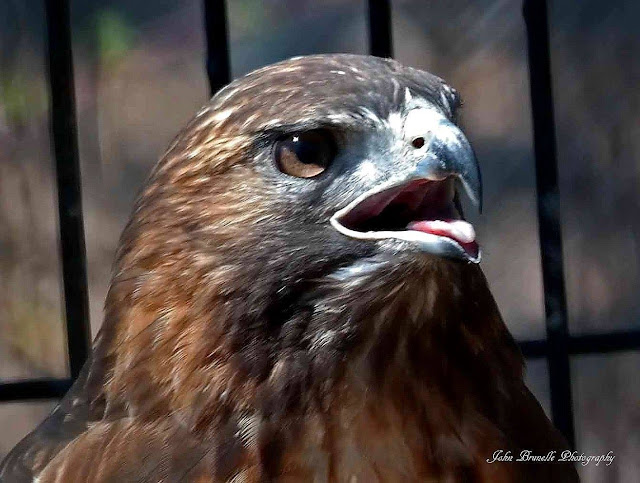Visitor FAQs: Why are birds of prey referred to as 'raptors'?
I recently watched the sequel to the Jurassic Park series of movies, Jurassic World. I was impressed by the fact that it stayed true to the spirit and adventure of the original Jurassic Park movies but with enhanced and modernized special effects. And of course it featured the small but fearsome "raptors", that were now fully computer animated.
The other night I was leading an evening nature walk at the nature center where I work in the south suburbs of Chicago, and we were looking at our resident hawks and owl. I mentioned that hawks and owls were members of a group of birds known as raptors, or birds of prey. One gentlemen jumped up and exclaimed, "Raptors? You mean like dinosaurs?" I chuckled a bit and explained that the term raptors refers to birds of prey, not the semi-mythical dinosaurs that reach down and grab unobservant bystanders with their giant claws and gnarly teeth.
The term raptor is derived from the Latin word "rapere" which loosely translates as to capture or seize. If you've ever watched a bird such as a red tailed hawk (Buteo jamaicensis) (figures 1, 2, and 3) hunting then you will quickly learn why they deserve to be called raptors! Raptors include hawks, owls, falcons, kites, osprey, and eagles. All of these birds have sharp talons and curved bills (beaks) that can shred a part a prey animal such as a mouse. Raptors are ambush predators that pounce on a prey animal and then seize them with their talons and claws.
The term raptors that we think of as for dinosaurs is derived from the scientific genus of the Velociraptor (or raptor if abbreviated) which was a small to medium-sized dinosaur which went extinct over 70 million years ago. Much like the bird raptors of today, Velocirpator was a voracious predator with large talon-like claws who was likely capable of seizing prey very quickly. There is also some evidence to suggest that had feathers on part or all of its body!
So, if you hear a naturalist talk about raptors today , they are most likely talking about one of the many birds of prey that are found soaring the skies across Illinois and North America. No need to worry about a velociraptor sneaking up behind you!
The other night I was leading an evening nature walk at the nature center where I work in the south suburbs of Chicago, and we were looking at our resident hawks and owl. I mentioned that hawks and owls were members of a group of birds known as raptors, or birds of prey. One gentlemen jumped up and exclaimed, "Raptors? You mean like dinosaurs?" I chuckled a bit and explained that the term raptors refers to birds of prey, not the semi-mythical dinosaurs that reach down and grab unobservant bystanders with their giant claws and gnarly teeth.
The term raptor is derived from the Latin word "rapere" which loosely translates as to capture or seize. If you've ever watched a bird such as a red tailed hawk (Buteo jamaicensis) (figures 1, 2, and 3) hunting then you will quickly learn why they deserve to be called raptors! Raptors include hawks, owls, falcons, kites, osprey, and eagles. All of these birds have sharp talons and curved bills (beaks) that can shred a part a prey animal such as a mouse. Raptors are ambush predators that pounce on a prey animal and then seize them with their talons and claws.
 |
| Figure 1: Red tailed hawk. Take notice of the sharp, curved bill typical of raptors. Photo credits: John Brunelle. |
 |
| Figure 2: Red-tailed hawk. Take notice of the sharp claws on its talons (feet). |
 |
| Figure 3: Raptors are ambush predators that seize its prey with its talons. This red-tailed hawk most likely just caught a small rodent. |
The term raptors that we think of as for dinosaurs is derived from the scientific genus of the Velociraptor (or raptor if abbreviated) which was a small to medium-sized dinosaur which went extinct over 70 million years ago. Much like the bird raptors of today, Velocirpator was a voracious predator with large talon-like claws who was likely capable of seizing prey very quickly. There is also some evidence to suggest that had feathers on part or all of its body!
So, if you hear a naturalist talk about raptors today , they are most likely talking about one of the many birds of prey that are found soaring the skies across Illinois and North America. No need to worry about a velociraptor sneaking up behind you!



Comments
Post a Comment